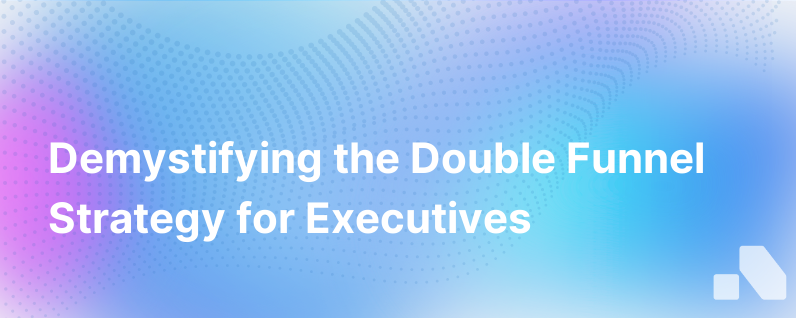
The "double funnel" concept has been evolving within the realms of digital marketing and sales with the purpose of optimizing and better integrating the alignment between marketing and sales teams. Traditionally, organizations have deployed separate funnels for marketing and sales, a practice that can create redundancy, misalignment, and missed opportunities.
The double funnel aims to challenge traditional siloed approaches by emphasizing a holistic view of the buyer's journey, from initial awareness to post-sale customer advocacy. However, there's been considerable debate on the feasibility, efficiency, and overall effectiveness of this model. In this article, we'll uncover the layers behind the double funnel strategy and dive into why some might dismiss it as "nonsense" while others herald it as a revelation.
Deconstructing the Double Funnel
At its core, the double funnel merges the marketing funnel, which typically ends at lead generation, with the sales funnel, which focuses on converting these leads into paying customers. But what discussions about the double funnel often miss is that this isn't about having two separate funnels at all; it's about creating a cohesive, end-to-end experience where marketing and sales processes and data constantly feed into and reinforce each other.
The concept advocates for a symbiotic relationship between the two functions, rather than treating them as distant cousins. Marketing teams continue nurturing leads at every phase, even after they've been passed to sales, ensuring a consistent and personalized journey for the prospective customer.
Why Some Call it Nonsense
Now, let's address why some market players might refer to the double funnel as "nonsense."
-
Complexity Over Clarity: At first glance, the double funnel can imply an added layer of complexity to customer acquisition strategies. The integration of two traditionally separate processes can seem daunting, causing apprehension around adopting the model.
-
Measurement Challenges: The double funnel can blur the lines of accountability and make it difficult to measure and attribute success accurately. This ambiguity can lead organizations to question the return on investment (ROI) of their marketing and sales activities.
-
Cultural Resistance: Ingrained organizational habits and resistance to change can make the transition towards a double funnel strategy difficult. Historically distinct teams with different objectives, KPIs, and cultures might resist an integrated approach.
-
Resource Intensiveness: Implementing and maintaining a double funnel approach demands a higher level of coordination, communication, and potentially, technology implementation. For some organizations, especially smaller and resource-constrained ones, this may not feel feasible.
Embracing the Double Funnel
Despite skepticism, adopting a double funnel can provide monumental benefits. Here's why embracing the strategy can revamp your customer acquisition and retention efforts:
- Seamless Customer Experience: By allowing for continuous communication and shared intelligence between marketing and sales, customers experience a smooth transition, improving satisfaction and potentially enhancing conversion rates.
- Enhanced Lead Quality: Marketers don't just hand off leads and forget them; they stay engaged, optimizing the lead's journey based on sales feedback and effectively qualifying leads further up the funnel.
- Data-Driven Decisions: A double funnel strategy means shared data across teams, leading to better-informed decisions that can improve tactics on both sides of the funnel.
- Consolidated Technologies and Resources: A well-executed double funnel strategy can lead to a more efficient use of technologies and resources, consolidating tools that serve both marketing and sales and reducing duplicated efforts.
Examples and Strategies for the Double Funnel in Action
To really understand the potential of a double funnel approach, let's explore how companies can and have actualized this strategy:
Shared KPIs and Collaboration Platforms
Instead of using separate tools and metrics, teams collaborate on platforms like Salesforce or HubSpot, tracking shared KPIs like MQL to SQL conversions, customer engagement scores, or overall customer lifetime value.
Regular Cross-departmental Meetings
Marketing and sales teams meet regularly to review the progress of leads through the funnel, exchange feedback, and tweak campaigns or sales strategies accordingly.
Unified Content Strategy
Marketing creates content not only to attract and engage leads but also to support sales in nurturing and closing deals. Content is personalized based on data continuously shared between teams.
The Verdict on the Double Funnel
So, is the double funnel strategy nonsensical or noteworthy? The answer depends heavily on execution. If an organization can foster the necessary culture, process, and technology integrations, the double funnel becomes a framework for uniting marketing and sales in a common mission to not only acquire but also expand customer relationships.
Startups and mature businesses alike can benefit from the cross-pollination of data and strategy that the double funnel promotes, but they must commit to the transition and face the growing pains that come with change.
Ultimately, the double funnel model can help in creating a more cohesive, efficient, and customer-centric approach to the buyer's journey. Far from nonsensical, it is a stroke of strategic innovation — provided it's done responsibly and realistically.